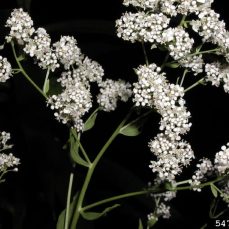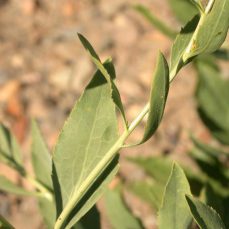
Photo credit: Leslie J. Mehrhoff, University of Connecticut, Bugwood.org
Management Category
Squamish
Whistler
Pemberton
Vectors of Spread
Synonyms
- Tall whitetop
- Virginia pepperweed
- Broadleaved peppergrass
- Broadleaved pepperweed
ID Characteristics
General: Perennial pepperweed is a herbaceous perennial in the Mustard family (Brassicaceae). In medieval Britain, the seeds were known as “poor man’s pepper” and the roots were a substitute for horseradish.
Flowers: White, four-petal flowers that form dense clusters at the end of branches.
Stems: Are branched, erect, waxy and grey-green, occasionally with red spots. Stems can grow up to 2 m tall and are woody at the base.
Leaves: Rosette leaves are oval or oblong with smooth or jagged edges. Stem leaves attach directly to the base of the plant in an alternate arrangement, and are lance-shaped with smooth to toothed margins. Leaves become smaller towards the top of the stem.
Seeds: Are small (1.5 mm), flat, and round or oval-shaped. Each seed pod contains two seeds.
Roots: Are deep, minimally branched, and enlarged at the soil surface, forming a semi-woody grown.
Similar Species
Invasive:
Hoary cress (Lepidium draba) is considerably shorter than perennial pepperweed, and its upper leaves clasp the stem.

Photo credit: Joseph M. DiTomaso, University of California – Davis, Bugwood.org
Baby’s breath (Gypsophila paniculata) flowers can also be confused with perennial pepperweed. However, baby’s breath is much shorter (up to 1 m tall) and its leaves are much narrower.

Photo credit: R. Mueller
Native:
Pearly everlasting (Anaphalis margaritacea) is shorter than perennial pepperweed. Its leaves are also narrower and give off a grey hue due to the fine hairs that cover the leaves and stems.

Photo credit: G. Neish
Habitat and Origin
Perennial pepperweed is native to southeastern Europe and southwestern Asia. It is believed to have been introduced to North America in a shipment of sugar beet seeds.
The plant tolerates a variety of soil characteristics, such as clayey, loamy, sandy or silty. It is also tolerant of calcium-rich soils. Perennial pepperweed invades flood plains, irrigation structures, pastures, wetlands, riparian areas, roadsides, dry hillsides and residential sites.
How it Spreads
Perennial pepperweed reproduces primarily vegetatively; its rhizomes can grow up to 3 m annually and new plants can form from root fragments. Reproduction by seeds is possible as well.
Local dispersal occurs predominately through the creeping rhizome system. However, perennial pepperweed can spread through its seeds which can be transported in water or by attaching themselves to farm equipment, livestock and wildlife.
Long-distance dispersal occurs by contaminated seeds and hay mixes, the horticulture industry, and vehicles.
Impacts
Ecological:
- Decreases native biodiversity by creating a monoculture.
- Increases soil salinity.
- Decreases availability of suitable nesting habitats.
Economic:
- Reduces forage quality and makes horses and cattle sick by preventing sodium and water retention.
Prevent the Spread
Perennial pepperweed is NOT currently found in the Sea to Sky Corridor, so the best approach to controlling its spread is by PREVENTION.
This is a high-priority invasive species for the Province of BC, and it is included in the Early Detection and Rapid Response (EDRR) program.
If you see perennial pepperweed, please report it.
B.C. Distribution
Perennial Pepperweed Factsheet
Having trouble viewing the factsheet? Don’t worry, all the information is included on this page. You can also contact us with any questions.
Additional Resources
References
- Caribou Regional District, Perennial Pepperweed
- Fraser Valley Invasive Species Society, Perennial pepperweed
- Government of Canada, Invasive Species Alert: Perennial Pepperweed
- Invasive Plant Atlas of United States, Perennial pepperweed
- Invasive Species Council of BC, Perennial Pepperweed TIPS Factsheet
- University of California Agriculture & Natural Resources, Perennial Pepperweed












